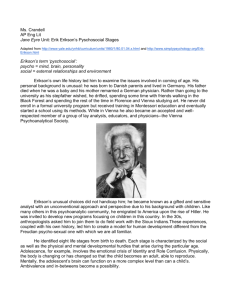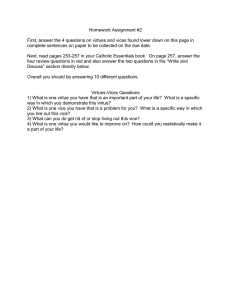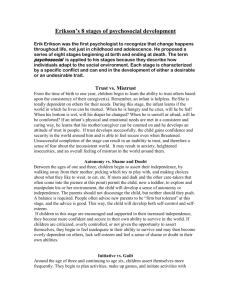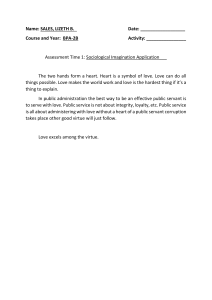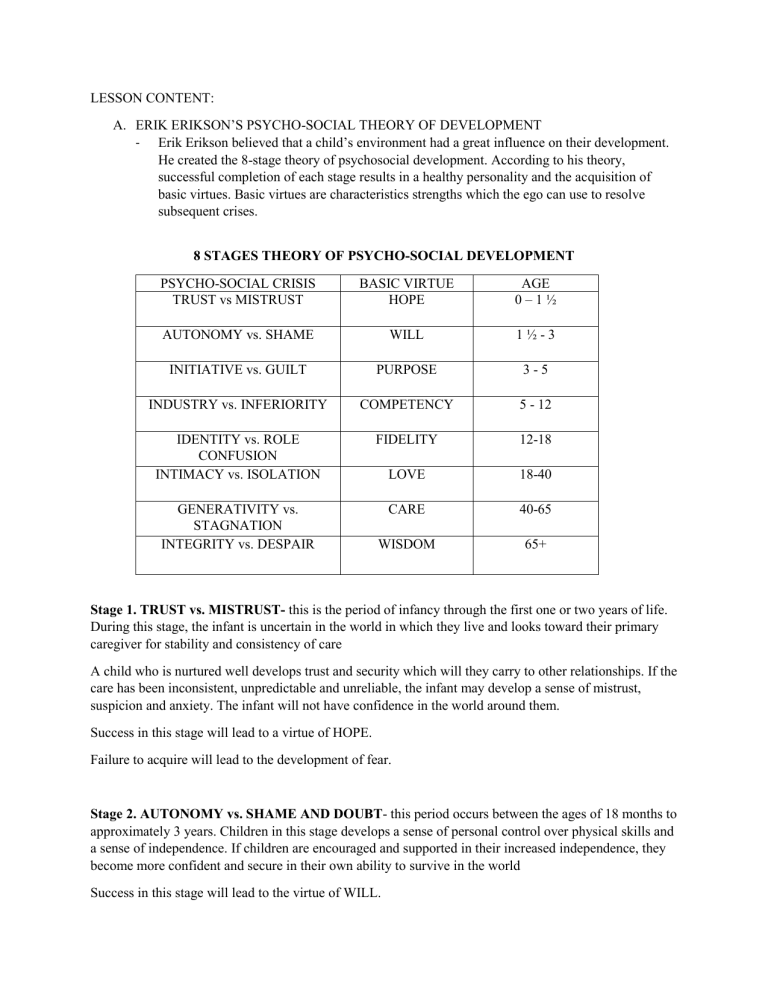
LESSON CONTENT: A. ERIK ERIKSON’S PSYCHO-SOCIAL THEORY OF DEVELOPMENT - Erik Erikson believed that a child’s environment had a great influence on their development. He created the 8-stage theory of psychosocial development. According to his theory, successful completion of each stage results in a healthy personality and the acquisition of basic virtues. Basic virtues are characteristics strengths which the ego can use to resolve subsequent crises. 8 STAGES THEORY OF PSYCHO-SOCIAL DEVELOPMENT PSYCHO-SOCIAL CRISIS TRUST vs MISTRUST BASIC VIRTUE HOPE AGE 0–1½ AUTONOMY vs. SHAME WILL 1½-3 INITIATIVE vs. GUILT PURPOSE 3-5 INDUSTRY vs. INFERIORITY COMPETENCY 5 - 12 IDENTITY vs. ROLE CONFUSION INTIMACY vs. ISOLATION FIDELITY 12-18 LOVE 18-40 GENERATIVITY vs. STAGNATION INTEGRITY vs. DESPAIR CARE 40-65 WISDOM 65+ Stage 1. TRUST vs. MISTRUST- this is the period of infancy through the first one or two years of life. During this stage, the infant is uncertain in the world in which they live and looks toward their primary caregiver for stability and consistency of care A child who is nurtured well develops trust and security which will they carry to other relationships. If the care has been inconsistent, unpredictable and unreliable, the infant may develop a sense of mistrust, suspicion and anxiety. The infant will not have confidence in the world around them. Success in this stage will lead to a virtue of HOPE. Failure to acquire will lead to the development of fear. Stage 2. AUTONOMY vs. SHAME AND DOUBT- this period occurs between the ages of 18 months to approximately 3 years. Children in this stage develops a sense of personal control over physical skills and a sense of independence. If children are encouraged and supported in their increased independence, they become more confident and secure in their own ability to survive in the world Success in this stage will lead to the virtue of WILL. Overly controlled, criticized children begin to feel inadequate in their ability to survive and may become overly dependent upon others. They lack self-esteem and feel a sense of shame or doubt in abilities. 3. Stage 3. INITIATIVE vs. GUILT- These are the “play age” or the preschool years. As your child interacts socially and plays with others, they learn that they can take the initiative and control what happens. During this stage, the primary feature involves the child regularly interacting with other children at school. ● Children begin to plan activities ● make up games and initiate activities with others. ● To lead as well as to follow If this acquired, children feel secure in their ability to lead others and make decisions. The child will begin to ask many questions as his thirst for knowledge grows. If not attended by the parents, the child may feel guilty. Too much guilt can make the child slow to interact with others. Success in this stage will lead to the virtue of PURPOSE. Failure results in a sense of guilt. Stage 4 INDUSTRY vs. INFERIORITY- refers as the “school age”. Occurs during childhood between the ages of five and twelve. Children at this stage begins to ● read and write ● do things on their own ● mastering social skills, reading and arithmetic ● child’s peer group will gain greater significance and become a major source of self esteem If children are encouraged and reinforced for their initiative, they begin to feel competent and confident in their ability to achieve goals. If not, the child begins to feel inferior, doubting his own abilities and not reach his potential. Success in this stage will lead to the virtue of COMPETENCE. A child who is trusting, autonomous and full of initiative will learn easily enough to be industrious. However, the mistrusting child will doubt the future. Stage 5 IDENTITY vs. ROLE CONFUSION- Occurs during the adolescence. Major stage of development where the child has to learn roles he will occupy as an adult. In this stage, the adolescent reexamines her identity and try to find out exactly who he is. The body image of the adolescent changes. They will feel uncomfortable feeling about their body for a while until they can adapt and grow into the changes ● learns to answer satisfactorily ● children are more independent ● begin to look at the future in terms of career, relationships, families Success in this stage will lead to the virtue of FIDELITY. They begin to form their own identity based upon the outcome of their explorations. Failure to establish identity within society can lead to role confusion. The adolescent will begin to experiment with different lifestyles. Stage 6 INTIMACY vs. ISOLATION- During this stage, the major conflict centers on forming intimate, loving relationships with other people. Takes place between the age of approximately 18-40 years. During this stage: ● we begin to share ourselves more intimately with others ● we explore relationships toward longer-term commitments Successful completion of this stage can result in a happy relationship and sense of commitment. Stage 7 GENERATIVITY vs STAGNATION- Takes place during middle adulthood ages 40-65 years. In this stage, middle age individuals experience a need to nurture things that will outlast them and create positive changes that will benefit other people. Success leads to feeling of usefulness and accomplishment. Failure results in shallow involvement of the world. By failing to find a way to contribute, we become stagnant and unproductive. Stage 8 EGO INTEGRITY vs DESPAIR- begins at approximately age 65 and ends at death. It is at this time that we contemplate our accomplishments and can develop integrity if we see ourselves as leading a successful life. If we see our lives as unproductive, feel guilty about our past, feel that we did not accomplish our life goals, we become dissatisfied with life and develop despair, often leading to depression and hopelessness
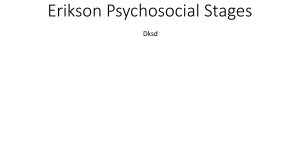
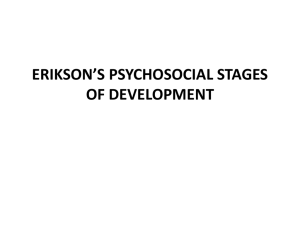
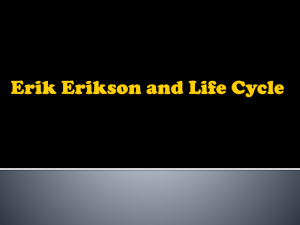

![Erikson's Stages of Psychosocial Development [PPT]](http://s3.studylib.net/store/data/009751159_1-0172a620c7b464562e5ad910610924d1-300x300.png)
